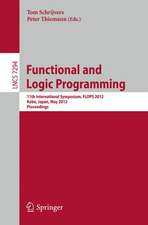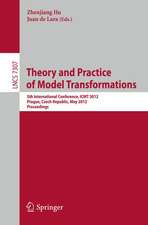Human-Centered Software Engineering: Software Engineering Models, Patterns and Architectures for HCI: Human–Computer Interaction Series
Editat de Ahmed Seffah, Jean Vanderdonckt, Michel C. Desmaraisen Limba Engleză Hardback – 22 iun 2009
| Toate formatele și edițiile | Preț | Express |
|---|---|---|
| Paperback (1) | 993.42 lei 6-8 săpt. | |
| SPRINGER LONDON – 28 oct 2010 | 993.42 lei 6-8 săpt. | |
| Hardback (1) | 999.85 lei 6-8 săpt. | |
| SPRINGER LONDON – 22 iun 2009 | 999.85 lei 6-8 săpt. |
Din seria Human–Computer Interaction Series
- 20%
 Preț: 655.85 lei
Preț: 655.85 lei - 20%
 Preț: 309.27 lei
Preț: 309.27 lei - 20%
 Preț: 375.54 lei
Preț: 375.54 lei - 20%
 Preț: 644.48 lei
Preț: 644.48 lei - 20%
 Preț: 667.75 lei
Preț: 667.75 lei - 20%
 Preț: 664.44 lei
Preț: 664.44 lei - 20%
 Preț: 1164.84 lei
Preț: 1164.84 lei - 20%
 Preț: 817.55 lei
Preț: 817.55 lei - 20%
 Preț: 657.16 lei
Preț: 657.16 lei - 20%
 Preț: 645.31 lei
Preț: 645.31 lei - 20%
 Preț: 938.66 lei
Preț: 938.66 lei - 15%
 Preț: 658.05 lei
Preț: 658.05 lei - 20%
 Preț: 822.51 lei
Preț: 822.51 lei - 20%
 Preț: 654.21 lei
Preț: 654.21 lei - 20%
 Preț: 994.26 lei
Preț: 994.26 lei - 20%
 Preț: 1621.89 lei
Preț: 1621.89 lei - 20%
 Preț: 991.60 lei
Preț: 991.60 lei - 20%
 Preț: 783.46 lei
Preț: 783.46 lei - 20%
 Preț: 1175.42 lei
Preț: 1175.42 lei - 20%
 Preț: 659.97 lei
Preț: 659.97 lei - 20%
 Preț: 219.15 lei
Preț: 219.15 lei - 20%
 Preț: 334.86 lei
Preț: 334.86 lei - 20%
 Preț: 969.85 lei
Preț: 969.85 lei - 20%
 Preț: 642.19 lei
Preț: 642.19 lei - 20%
 Preț: 314.39 lei
Preț: 314.39 lei - 20%
 Preț: 661.14 lei
Preț: 661.14 lei - 20%
 Preț: 995.89 lei
Preț: 995.89 lei - 20%
 Preț: 752.59 lei
Preț: 752.59 lei - 20%
 Preț: 990.30 lei
Preț: 990.30 lei - 20%
 Preț: 990.12 lei
Preț: 990.12 lei - 20%
 Preț: 336.21 lei
Preț: 336.21 lei - 20%
 Preț: 334.71 lei
Preț: 334.71 lei - 20%
 Preț: 312.62 lei
Preț: 312.62 lei - 20%
 Preț: 994.92 lei
Preț: 994.92 lei - 20%
 Preț: 331.74 lei
Preț: 331.74 lei - 20%
 Preț: 646.80 lei
Preț: 646.80 lei - 20%
 Preț: 334.86 lei
Preț: 334.86 lei - 20%
 Preț: 994.40 lei
Preț: 994.40 lei - 20%
 Preț: 329.76 lei
Preț: 329.76 lei - 20%
 Preț: 332.24 lei
Preț: 332.24 lei - 20%
 Preț: 992.11 lei
Preț: 992.11 lei - 20%
 Preț: 650.40 lei
Preț: 650.40 lei - 20%
 Preț: 337.00 lei
Preț: 337.00 lei - 20%
 Preț: 332.39 lei
Preț: 332.39 lei - 20%
 Preț: 1279.86 lei
Preț: 1279.86 lei - 15%
 Preț: 636.12 lei
Preț: 636.12 lei - 20%
 Preț: 336.67 lei
Preț: 336.67 lei - 20%
 Preț: 1000.70 lei
Preț: 1000.70 lei - 20%
 Preț: 645.14 lei
Preț: 645.14 lei
Preț: 999.85 lei
Preț vechi: 1249.82 lei
-20% Nou
Puncte Express: 1500
Preț estimativ în valută:
191.38€ • 207.95$ • 160.86£
191.38€ • 207.95$ • 160.86£
Carte tipărită la comandă
Livrare economică 21 aprilie-05 mai
Preluare comenzi: 021 569.72.76
Specificații
ISBN-13: 9781848009066
ISBN-10: 1848009062
Pagini: 428
Ilustrații: XXX, 398 p.
Dimensiuni: 155 x 235 x 30 mm
Greutate: 0.77 kg
Ediția:2009
Editura: SPRINGER LONDON
Colecția Springer
Seria Human–Computer Interaction Series
Locul publicării:London, United Kingdom
ISBN-10: 1848009062
Pagini: 428
Ilustrații: XXX, 398 p.
Dimensiuni: 155 x 235 x 30 mm
Greutate: 0.77 kg
Ediția:2009
Editura: SPRINGER LONDON
Colecția Springer
Seria Human–Computer Interaction Series
Locul publicării:London, United Kingdom
Public țintă
ResearchCuprins
Human-Centered Software Engineering: Software Engineering Architectures, Patterns, and Models for Human Computer Interaction.- Human-Centered Software Engineering: Software Engineering Architectures, Patterns, and Sodels for Human Computer Interaction.- User Experiences, Usability Requirements, and Design.- What Drives Software Development: Bridging the Gap Between Software and Usability Engineering.- Human Activity Modeling: Toward A Pragmatic Integration of Activity Theory and Usage-Centered Design.- A User-Centered Framework for Deriving A Conceptual Design From User Experiences: Leveraging Personas and Patterns to Create Usable Designs.- XML-Based Tools for Creating, Mapping, and Transforming Usability Engineering Requirements.- Modeling and Model-Driven Engineering.- Multipath Transformational Development of User Interfaces with Graph Transformations.- Human-Centered Engineering Of Interactive Systems With The User Interface Markup Language.- Megamodeling and Metamodel-Driven Engineering for Plastic User Interfaces: MEGA-UI.- Cause and Effect in User Interface Development.- Interactive Systems Architectures.- From User Interface Usability to the Overall Usability of Interactive Systems: Adding Usability in System Architecture.- Toward a Refined Paradigm for Architecting Usable Systems.- Trace-Based Usability Evaluation Using Aspect-Oriented Programming and Agent-Based Software Architecture.- Achieving Usability of Adaptable Software: The Amf-Based Approach.- Reengineering, Reverse Engineering, and Refactoring.- The Gains Design Process: How to do Structured Design of User Interfaces in Any Software Environment.- Legacy Systems Interaction Reengineering.- Using Reverse Engineering for Automated Usability Evaluation of Gui-Based Applications.- Task Models and SystemModels as A Bridge Between Hci and Software Engineering.
Recenzii
From the reviews:
"This book … is comprised of four sections and 17 chapters. The physical structure of the book is quite pleasing … . The editors have clearly thought about their chapter organization. … This publication is a testament to the importance of the convergence of software engineering and HCI. … this is a call to practitioners to take a larger role in creating better solutions, through a more ‘whole brain’ approach to a refined and sophisticated development model." (Brian D. Goodman, ACM Computing Reviews, October, 2009)
"This book … is comprised of four sections and 17 chapters. The physical structure of the book is quite pleasing … . The editors have clearly thought about their chapter organization. … This publication is a testament to the importance of the convergence of software engineering and HCI. … this is a call to practitioners to take a larger role in creating better solutions, through a more ‘whole brain’ approach to a refined and sophisticated development model." (Brian D. Goodman, ACM Computing Reviews, October, 2009)
Textul de pe ultima copertă
The fields of Human-Computer Interaction (HCI) and Software Engineering (SE) have evolved almost independently from each other until the last two decades, when it became obvious that an integrated perspective would benefit the development of interactive software applications as considered in both disciplines. The chapters in this book are written by prominent researchers and practitioners who bring to light the major issues and challenges posed by this integration, and offer a variety of solutions in order to address the integration of HCI and SE, including:
• Extensions of software development methodologies to accomodate for the specific constraints of usage-centered design.
• Introduction of innovative, structured, and model-driven user interface engineering approaches.
• Addressing software architecture issues in the design of user interfaces.
• Reingineering of existing systems for better usability.
• Extensions of software development methodologies to accomodate for the specific constraints of usage-centered design.
• Introduction of innovative, structured, and model-driven user interface engineering approaches.
• Addressing software architecture issues in the design of user interfaces.
• Reingineering of existing systems for better usability.



























